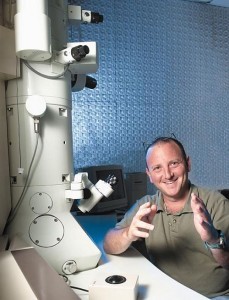“Science”: Technion researchers resolve 133-year-old theory – discover the nature of nanometer-scale layers between materials
 They have thereby added a crucial addition to Gibb’s theory of 1878, which partially explained what happens when different materials come into contact; the discovery has far-ranging implications for improving the bonding of different materials
They have thereby added a crucial addition to Gibb’s theory of 1878, which partially explained what happens when different materials come into contact; the discovery has far-ranging implications for improving the bonding of different materials
“In the 1980s scientists showed that there is a very thin layer between crystals, so thin that it could not be defined as liquid or solid,” explains Professor Wayne D. Kaplan, Dean of the Department of Materials Engineering at the Technion. “Researchers around the world had been unable to understand why this layer exists and if it is a temporary state or in a state of equilibrium so that, therefore, it is permanent. Researchers knew that it exists at the interface between ceramic crystals, as well as on the surface of ice (water-like layer which allows us to ice-skate), but there was still a big argument about the cause of this phenomenon and its properties.”
In her doctoral work carried out under the supervision of Prof. Kaplan and in cooperation with Dr. Dominique Chatain from the French research institute CNRS, Dr. Mor Baram proved, through a long series of experiments, that a layer exists at the interface between metals and ceramic materials, and apparently also at the interface between metals and semi-conductors. “This phenomenon enables us to ice-skate, reduces the mechanical properties of ceramic materials at high temperatures, but seemingly contributes to the stability of innovative micro-electronic devices,” says Prof. Kaplan.
The Technion researchers conducted experiments never done before, using the new “Titan” electron microscope and FIB, the latter being kind of a workshop on the nanometer scale. They plated sapphire with a thin film of gold, 0.6 microns thick (for comparison, a single strand of hair is 80-100 microns thick). The researchers heated the samples until they reached equilibrium; that is, until the gold films broke-up into billions of tiny gold crystals atop the sapphire. In parallel, there was a source of elements on top of the sapphire that the researchers already knew played a role in the layer between different materials (in their experiment – silicon and calcium). As the samples equilibrated, the calcium and silicon moved to the interface between the gold and sapphire and a thin layer, 0.0012 microns thick (1.2 nanometers), was created naturally, just 4-5 atoms wide.
“We successfully measured the energy stored between the gold and sapphire in the presence of the thin layer and proved by this that its presence layer decreases the energy of the interface, and therefore improves its stability,” explains Prof. Kaplan.
This scientific discovery by Technion researchers has technological implications, because this understanding will enable scientists to improve the resilience of the bond between ceramic materials and metals, two types of materials that “do not like” to come into contact. Examples include the join of missile domes to the missle body, the connection between metal conducting wires and chips in computers, and the protective ceramic coating on blades of jet engines.
Above: Professor Wayne D. Kaplan


